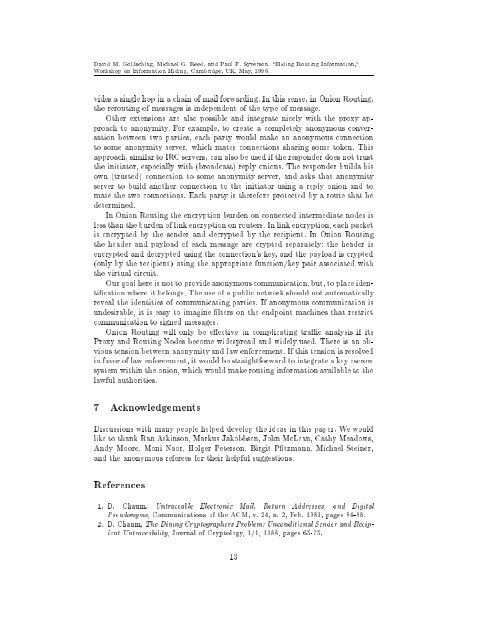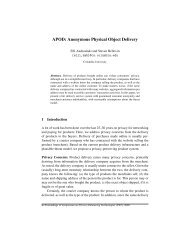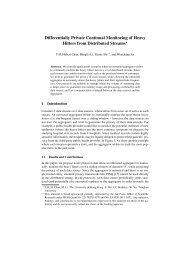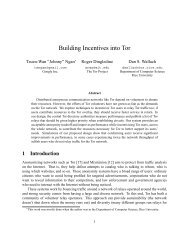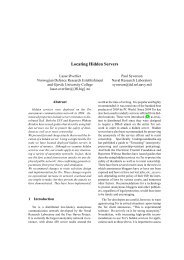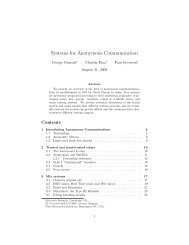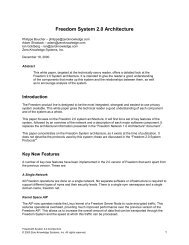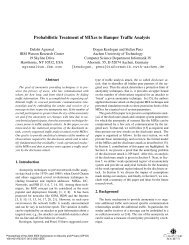Hiding Routing Information - Onion Routing
Hiding Routing Information - Onion Routing
Hiding Routing Information - Onion Routing
You also want an ePaper? Increase the reach of your titles
YUMPU automatically turns print PDFs into web optimized ePapers that Google loves.
David M. Goldschlag, Michael G. Reed, and Paul F. Syverson. \<strong>Hiding</strong> <strong>Routing</strong> <strong>Information</strong>,"Workshop on <strong>Information</strong> <strong>Hiding</strong>, Cambridge, UK, May, 1996.vides a single hop in a chain of mail forwarding. In this sense, in <strong>Onion</strong> <strong>Routing</strong>,the rerouting of messages is independent of the type of message.Other extensions are also possible and integrate nicely with the proxy approachto anonymity. For example, to create a completely anonymous conversationbetween two parties, each party would make an anonymous connectionto some anonymity server, which mates connections sharing some token. Thisapproach, similar to IRC servers, can also be used if the responder does not trustthe initiator, especially with (broadcast) reply onions. The responder builds hisown (trusted) connection to some anonymity server, and asks that anonymityserver to build another connection to the initiator using a reply onion and tomate the two connections. Each party is therefore protected by a route that hedetermined.In <strong>Onion</strong> <strong>Routing</strong> the encryption burden on connected intermediate nodes isless than the burden of link encryption on routers. In link encryption, each packetis encrypted by the sender and decrypted by the recipient. In <strong>Onion</strong> <strong>Routing</strong>the header and payload of each message are crypted separately: the header isencrypted and decrypted using the connection's key, and the payload is crypted(only by the recipient) using the appropriate function/key pair associated withthe virtual circuit.Our goal here is not to provide anonymous communication, but, to place identicationwhere it belongs. The use of a public network should not automaticallyreveal the identities of communicating parties. If anonymous communication isundesirable, it is easy to imagine lters on the endpoint machines that restrictcommunication to signed messages.<strong>Onion</strong> <strong>Routing</strong> will only be eective in complicating trac analysis if itsProxy and <strong>Routing</strong> Nodes become widespread and widely used. There is an obvioustension between anonymity and law enforcement. If this tension is resolvedin favor of law enforcement, it would be straightforward to integrate a key escrowsystem within the onion, which would make routing information available to thelawful authorities.7 AcknowledgementsDiscussions with many people helped develop the ideas in this paper. We wouldlike to thank Ran Atkinson, Markus Jakobbsen, John McLean, Cathy Meadows,Andy Moore, Moni Naor, Holger Peterson, Birgit Ptzmann, Michael Steiner,and the anonymous referees for their helpful suggestions.References1. D. Chaum. Untraceable Electronic Mail, Return Addresses, and DigitalPseudonyms, Communications of the ACM, v. 24, n. 2, Feb. 1981, pages 84-88.2. D. Chaum, The Dining Cryptographers Problem: Unconditional Sender and RecipientUntraceability, Journal of Cryptology, 1/1, 1988, pages 65-75.13


